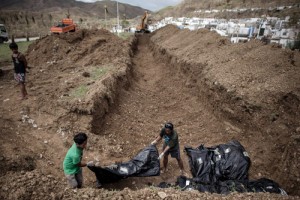Scores of decaying bodies were being taken to mass graves beginning on Thursday as overwhelmed Philippines authorities grappled with disposal of the dead and the living begged for help after the typhoon disaster.
The arrival of the USS George Washington, a huge aircraft carrier with 5,000 sailors aboard, offered some hope for the hungry and thirsty left to roam the ruined city of Tacloban.
But almost a week after Typhoon Yolanda (Haiyan) swept through the country’s central islands, crushing settlements and laying waste to an already poor area, the stench of putrefying flesh hung heavy in the air.
By mid-morning, some of the 200 corpses that had been lined up side-by-side at a local government building had been placed at the bottom of a huge pit expected to be several layers deep by the time it is covered over with earth.
“There are still so many cadavers in so many areas. It’s scary,” said Tacloban Mayor Alfred Romualdez, adding that retrieval teams were struggling to cope.
“There would be a request from one community to collect five or 10 bodies and when we get there, there are 40,” Romualdez told Agence France-Presse, saying that aid agencies’ response to the increasingly desperate crisis had been too slow.
Sick or injured people lie helplessly among the ruins of buildings, while those with the energy try to leave a place that resembles hell.
‘Fear and depression’
Efren Nagrama, area manager at the civil aviation authority, said conditions were “very dire now” as he surveyed the filthy stream of humanity at Tacloban’s battered airport clamoring to get a flight out.
“You see hundreds coming to the compound every day. People who have walked for days without eating, only to arrive here and be made to wait for hours or days under the elements,” he said.
“People are pushed to the tipping point—they see relief planes but cannot get to the food nor get a ride out. There is chaos.”
Romualdez said the people of Tacloban needed an “overwhelming response” from aid organizations and the government.
“We need more manpower and more equipment,” he pleaded.
“I cannot use a truck to collect cadavers in the morning and then use it to distribute relief goods in the afternoon,” he added.
“Let’s get the bodies out of the streets. They are creating an atmosphere of fear and depression.”
City officials estimate that they have collected 2,000 bodies but insist many more need to be retrieved. The UN fears that 10,000 people may have died in Tacloban city alone, but President Benigno Aquino 3rd has described that figure as “too much”.
While the retrieval operation gets going, there are growing fears for the health of those who survived.
AFP


